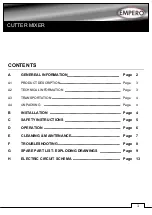
Appendices
16
Gate Types
GATE
A gate, or noise gate is essentially an audio switch used
to mute signals below a set threshold level. It can be used
to cut background noise picked up by open micro-
phones, noise and hiss from guitar valve amps and
effects pedals, and leakage between drum microphones.
It also has many creative uses too. For example, gating a
drum sound with a short decay time tightens up the
sound. Also, patching a gate into a droning bass synth
channel and then triggering it from the kick drum chan-
nel allows the bass synth through only when the kick
drum is struck, adding extra “oomph” on the beat.
THRESHOLD
—This determines the level at which the
gate closes, cutting off the signal. Signals above the
threshold level pass through unaffected. Signals at or
below the threshold, however, cause the gate to close.
The trigger signal is sourced using the KEY IN parame-
ter.
RANGE
—This determines the level to which the gate
closes. Think of it as a brick holding a garden gate open
so that a certain amount of signal always flows through.
For a setting of –70 dB, the gate closes completely when
the input signal falls below the threshold. For a setting of
–30 dB, however, the gate half closes. For a setting of
0 dB, the gate has no effect. When signals are gated
abruptly, the sudden disappearance can sometimes
sound odd. This parameter causes the gate to reduce the
signal level rather than cut it completely.
HOLD
—This determines how long the gate stays open
once the trigger signal has fallen below the threshold
level.
ATTACK
—This determines how fast the gate opens
when the signal exceeds the threshold level. Slow attack
times can be used to remove the initial transient edge of
percussive sounds. Too slow an attack time makes some
sounds appear backwards.
DECAY
—This determines how fast the gate closes once
the hold time has expired. A longer decay time produces
a more natural gating effect, allowing the natural decay
of an instrument to pass through. With a maximum
decay time of between 42 and 46 seconds, you could
even use this for fade-outs.
–70
–60
–50
–40
–30
–20
–10
0
+10
+20
–70
–60
–50
–40
–30
–20
–10
0
+10
+20
Input Level (dB)
Output Level (dB)
Threshold = –10dB
Range = –30dB
Range = –70dB
Parameter
Range
THRESHOLD
–54 dB to 0 dB (1 dB steps)
RANGE
–70 dB to 0 dB (1 dB steps)
HOLD
0.02 ms–1.96 s (fs = 48 kHz)
0.02 ms–2.13 s (fs = 44.1 kHz)
ATTACK
0–120 ms (1 ms steps)
DECAY
5 ms–42.3 s (fs = 48 kHz)
6 ms–46 s (fs = 44.1 kHz)
Содержание CS1D
Страница 14: ...Owner s Manual ...
Страница 18: ...Operating Manual ...
Страница 19: ...Operating Manual Start up ...
Страница 68: ...Operating Manual Basic Operation ...
Страница 227: ...Reference Manual ...
Страница 228: ...Reference Manual Hardware ...
Страница 345: ...Reference Manual Software ...
Страница 543: ...Reference Manual Appendices ...
















































